Being a record of my journey as I undertake a new role that, unlike many others I have played, fills me with a sense of immense challenge and a promise of growth, both as an actor and a seeker.
Facebook status, February 11th, 2013: What an amazing first day of rehearsal for The Whale, at South Coast Rep. A wonderful director, incredible cast, great creative team, and an incredibly moving and ultimately inspiring play. So thrilled to be a part of this production.
The first day of rehearsal at South Coast Rep is always so exciting. It starts with a meet-and-greet in the Argyros Theater, where we will be performing. The artistic and managing directors welcome and introduce the playwright, cast, and creative team to the assembled staff at the theater, all of the many people in the different departments that make a huge organization like the Rep run. The director says a few words, and the designers, costume, set, and lighting, present their models and sketches, describing the concept for the show. Next, the cast retires to the rehearsal hall to elect an Equity deputy, sign contracts, and take care of other administrative business. Then a big crowd, all the folks from marketing, wardrobe, props, and other departments, gather to hear the first reading of the script. This reading is somewhat more a performance than part of the rehearsal process proper, to give those assembled a feel for the tone and energy of the play. After that read-through, there are many congratulations and declarations of what a great show this is going to be. Finally, all depart, except for the director, playwright, stage management team, and the actors, and we are left with the small group that will spend the next three weeks in this windowless basement space, getting to know this piece, and each other, intimately. We read the play again, without the pressure of an audience, stopping, discussing, beginning the process of dissection. At the end of the day, we join the rest of the theater staff again to relax at a social gathering on the patio in front of the theater, snacking, drinking soda, beer, or wine. The next day we return to begin our work in earnest.
The first day of rehearsal at South Coast Rep is always so exciting. It starts with a meet-and-greet in the Argyros Theater, where we will be performing. The artistic and managing directors welcome and introduce the playwright, cast, and creative team to the assembled staff at the theater, all of the many people in the different departments that make a huge organization like the Rep run. The director says a few words, and the designers, costume, set, and lighting, present their models and sketches, describing the concept for the show. Next, the cast retires to the rehearsal hall to elect an Equity deputy, sign contracts, and take care of other administrative business. Then a big crowd, all the folks from marketing, wardrobe, props, and other departments, gather to hear the first reading of the script. This reading is somewhat more a performance than part of the rehearsal process proper, to give those assembled a feel for the tone and energy of the play. After that read-through, there are many congratulations and declarations of what a great show this is going to be. Finally, all depart, except for the director, playwright, stage management team, and the actors, and we are left with the small group that will spend the next three weeks in this windowless basement space, getting to know this piece, and each other, intimately. We read the play again, without the pressure of an audience, stopping, discussing, beginning the process of dissection. At the end of the day, we join the rest of the theater staff again to relax at a social gathering on the patio in front of the theater, snacking, drinking soda, beer, or wine. The next day we return to begin our work in earnest.
Facebook Status, February 13, 2013: Ah, those wonderful first days of blocking a show, when you realize that you have completely forgotten how to act, and you know in your heart it will never come together. Thank God I’ve been through this enough to know that this is only a phase, a necessary part of the process, when we dismantle the whole thing so that we can put it back together, whole, complete, alive. What a great team we have on this journey.
The first week of rehearsal I am struggling through a big learning curve. I’m trying to track the downward spiral of my (Charlie’s) health, working on wheezing and shortness of breath, trying to figure out how to keep that going without hyperventilating or damaging my voice. How do I realistically represent someone who can’t get any breath, and still make sure that I am heard in a 336 seat two-tiered house? I’m trying to understand the symptoms of congestive heart failure, so that I can make my physical symptoms and limitations as specific as possible, rather than projecting a general portrait of someone who just feels lousy all the time. Where does it hurt? How much? When? The theater connects me to two doctors who give me some insights, but this presents an additional wrinkle. Some of what might be authentic has to be expanded or modified for dramatic purposes. What is realistic doesn’t always tell the story in the best way.
Facebook Status, February 14, 2013: This is exactly how I feel, every time the stage manager says, “Okay, let’s take ten.” (This post is linked to a video, illustrating the feeling.)
I am working in the prosthetic suit, which I refer to as my body, for half the rehearsal day period each day. That’s about 3 hours, or just about as long as the ice packs last in the cooling vest. Getting into the suit is an ordeal, but it’s getting a bit easier each day as we practice. The suit itself is such an amazing, intricate piece of design, it deserves another post all to itself, but that will have to wait until after the show opens, so that we don’t spoil the “reveal.” For now, suffice it to say that wearing the suit in rehearsal is exhausting, but necessary. The prosthetic becomes the obstacle through which I am struggling, instead of my having to pretend that there’s an obstacle. The first time I sit down on, and then try to get up from, the couch on the set, everyone watches. “Wow, that was fantastic,” they say. “It looked so realistic, like you were really struggling.”
“Really?” I reply. “Because I was just trying to get off the couch.” I love it when props and costumes do the work. I’m fundamentally lazy, and then I don’t actually have to “act.”
At the end of the first week, the cast comes over to the home of my friend Mitch Cohen, where I’m crashing during this production. We throw some steaks on the grill and have our first chance to relax and bond outside of rehearsal. Mitch is a former student of mine from the South Coast Rep conservatory. After he took my class, I coached him for an audition for a role that he really, really wanted to land. I’m happy to say he’s in rehearsal himself right now for a production of Brooklyn Boy at Newport Theater Arts Center. When I got The Whale, he told me I should stay with him to save myself the commute back and forth from LA, and also so we could spend time helping each other learn our lines. It’s good thing he made the offer, because this play is the most rigorous I have ever done. Staying with him gives me the luxury of focusing on a single-minded daily schedule, as follows:
The last day of our second week of rehearsal. I have been struggling to be off book enough to make it through this without holding my script for any of the scenes. The only one I am sure about is Thursday Afternoon, but that’s only because, although I am on stage, I’m asleep through the whole scene. Which is a good thing. It gives me a breather before the race to the end, which feels like kicking it out in a sprint at the end of a marathon.
Before the stumble-through, I talk to Martin about the plan for the next week. I am hoping to have the chance to do each scene a few times without the struggling for breath. I have been focusing on that so much that I feel that I haven’t fully explored some of the relationships and events enough. The cardiac and breathing problems are happening to Charlie, not something that he is himself trying to make happen. It is the other things in the scene that he is struggling to achieve, things that he wants from the other characters, and I feel that I have been losing track of those because my attention has been split. Martin agrees that we should to do that, but I also realize his wisdom in having me try to tackle the breathing from the beginning, before we take it out to work on the other elements. We need to feel confident that it’s going to work when we put it back in, and the other cast members have needed to see it, because my condition has such a strong impact on their own emotional life.
Acting always involves multitasking, but Charlie requires much more of me than usual. I feels like someone is saying, “Pat your head. Now rub your belly. Okay, now lift your left foot up and balance a plate on it. Now hop up and down on your right foot. Now sing “Una Furtiva Lagrima. Oooops, you’re not patting your head … okay good, but now you dropped the plate.” But we still have two weeks till the first performance. Plenty of time. I’ll get it.
We start the stumble-through, and it goes better than any of us thought it would, I suspect. That is until about twenty minutes before the end, when my hands start to tingle, then go numb, and I am totally lost, with no idea where I was in the story. This is not the normal “What’s my line” or “What happens next?” moment. I am completely disoriented. I’m not sure exactly what happened, but I think I was experiencing something similar to what athletes call the “bonk.” We stop for a few minutes, I eat an orange, drink some water. The feeling returns to my fingers, my hands stop shaking so much, and I’m able to refocus and get through to the end.
The first stumble-through, as daunting as it is, is always such a rewarding experience. After pulling the text apart, it is so good to put the pieces back together, as rough as it might be, so that again we can get a sense of the arc of the whole show. For me, in this show, it has helped me to see how I have to pace myself, and also showed me that a lot of the progression of the physical symptoms, and the heightening of the emotional circumstances, will be easier to do when the scenes are stitched together and each element is occurring in context. It also helped us to figure out that there’s got to be plenty of Gatorade around, so that the audience doesn’t have to come back to the theater on another day, to catch the rest of the show.
For more information about this production of The Whale, visit the the South Coast Rep website, and please be sure to sign up for my newsletter.
The first week of rehearsal I am struggling through a big learning curve. I’m trying to track the downward spiral of my (Charlie’s) health, working on wheezing and shortness of breath, trying to figure out how to keep that going without hyperventilating or damaging my voice. How do I realistically represent someone who can’t get any breath, and still make sure that I am heard in a 336 seat two-tiered house? I’m trying to understand the symptoms of congestive heart failure, so that I can make my physical symptoms and limitations as specific as possible, rather than projecting a general portrait of someone who just feels lousy all the time. Where does it hurt? How much? When? The theater connects me to two doctors who give me some insights, but this presents an additional wrinkle. Some of what might be authentic has to be expanded or modified for dramatic purposes. What is realistic doesn’t always tell the story in the best way.
Facebook Status, February 14, 2013: This is exactly how I feel, every time the stage manager says, “Okay, let’s take ten.” (This post is linked to a video, illustrating the feeling.)
I am working in the prosthetic suit, which I refer to as my body, for half the rehearsal day period each day. That’s about 3 hours, or just about as long as the ice packs last in the cooling vest. Getting into the suit is an ordeal, but it’s getting a bit easier each day as we practice. The suit itself is such an amazing, intricate piece of design, it deserves another post all to itself, but that will have to wait until after the show opens, so that we don’t spoil the “reveal.” For now, suffice it to say that wearing the suit in rehearsal is exhausting, but necessary. The prosthetic becomes the obstacle through which I am struggling, instead of my having to pretend that there’s an obstacle. The first time I sit down on, and then try to get up from, the couch on the set, everyone watches. “Wow, that was fantastic,” they say. “It looked so realistic, like you were really struggling.”
“Really?” I reply. “Because I was just trying to get off the couch.” I love it when props and costumes do the work. I’m fundamentally lazy, and then I don’t actually have to “act.”
At the end of the first week, the cast comes over to the home of my friend Mitch Cohen, where I’m crashing during this production. We throw some steaks on the grill and have our first chance to relax and bond outside of rehearsal. Mitch is a former student of mine from the South Coast Rep conservatory. After he took my class, I coached him for an audition for a role that he really, really wanted to land. I’m happy to say he’s in rehearsal himself right now for a production of Brooklyn Boy at Newport Theater Arts Center. When I got The Whale, he told me I should stay with him to save myself the commute back and forth from LA, and also so we could spend time helping each other learn our lines. It’s good thing he made the offer, because this play is the most rigorous I have ever done. Staying with him gives me the luxury of focusing on a single-minded daily schedule, as follows:
- Get up, shower, drink a large glass of water, then coffee and an egg white omelette. Take care of necessary emails and assignments for my acting class. Record and send any voiceover auditions that came in the day before.
- Drive to Starbuck’s near the theater. Another cup of coffee. Study lines and work on the script. Sitting alone with script, after the first time of putting each scene on it’s feet is always a great time to pull it apart even more, to break things down in the actual story, to get the timeline and present circumstances of each relationship and scene fixed in my mind. We always rush, rush, rush, when we’re first running through scenes, especially if it is stuff that your character is doing alone on stage. It’s important to go over things in slow motion in your mind, to figure out the moment-to-moment beats.
- Stop at Trader Joe’s next to Starbuck’s and pick up a salad to have during rehearsal break, and something healthy-ish to have for dinner. Then get to the theater early, and check in at the costume department about any changes to my body, and then get into my body when rehearsal starts.
- Rehearse for three hours.
- Get out of my body and rehearse for another 3 hours.
- Go back to Mitch’s house. Have some dinner, maybe a scotch or a glass of wine. Watch some mindless TV, go to bed.
- Rinse and repeat.
The last day of our second week of rehearsal. I have been struggling to be off book enough to make it through this without holding my script for any of the scenes. The only one I am sure about is Thursday Afternoon, but that’s only because, although I am on stage, I’m asleep through the whole scene. Which is a good thing. It gives me a breather before the race to the end, which feels like kicking it out in a sprint at the end of a marathon.
Before the stumble-through, I talk to Martin about the plan for the next week. I am hoping to have the chance to do each scene a few times without the struggling for breath. I have been focusing on that so much that I feel that I haven’t fully explored some of the relationships and events enough. The cardiac and breathing problems are happening to Charlie, not something that he is himself trying to make happen. It is the other things in the scene that he is struggling to achieve, things that he wants from the other characters, and I feel that I have been losing track of those because my attention has been split. Martin agrees that we should to do that, but I also realize his wisdom in having me try to tackle the breathing from the beginning, before we take it out to work on the other elements. We need to feel confident that it’s going to work when we put it back in, and the other cast members have needed to see it, because my condition has such a strong impact on their own emotional life.
Acting always involves multitasking, but Charlie requires much more of me than usual. I feels like someone is saying, “Pat your head. Now rub your belly. Okay, now lift your left foot up and balance a plate on it. Now hop up and down on your right foot. Now sing “Una Furtiva Lagrima. Oooops, you’re not patting your head … okay good, but now you dropped the plate.” But we still have two weeks till the first performance. Plenty of time. I’ll get it.
We start the stumble-through, and it goes better than any of us thought it would, I suspect. That is until about twenty minutes before the end, when my hands start to tingle, then go numb, and I am totally lost, with no idea where I was in the story. This is not the normal “What’s my line” or “What happens next?” moment. I am completely disoriented. I’m not sure exactly what happened, but I think I was experiencing something similar to what athletes call the “bonk.” We stop for a few minutes, I eat an orange, drink some water. The feeling returns to my fingers, my hands stop shaking so much, and I’m able to refocus and get through to the end.
The first stumble-through, as daunting as it is, is always such a rewarding experience. After pulling the text apart, it is so good to put the pieces back together, as rough as it might be, so that again we can get a sense of the arc of the whole show. For me, in this show, it has helped me to see how I have to pace myself, and also showed me that a lot of the progression of the physical symptoms, and the heightening of the emotional circumstances, will be easier to do when the scenes are stitched together and each element is occurring in context. It also helped us to figure out that there’s got to be plenty of Gatorade around, so that the audience doesn’t have to come back to the theater on another day, to catch the rest of the show.
For more information about this production of The Whale, visit the the South Coast Rep website, and please be sure to sign up for my newsletter.
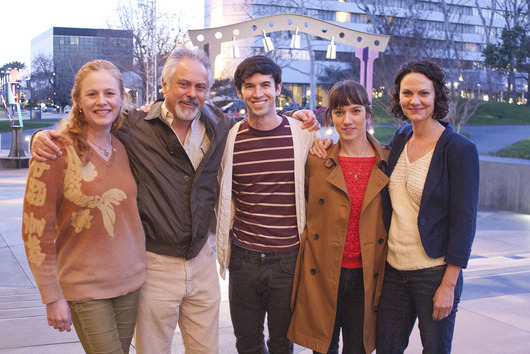
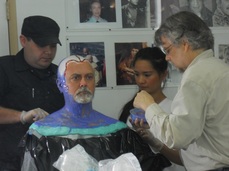
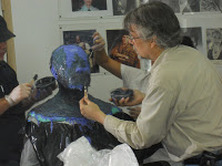
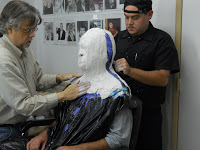
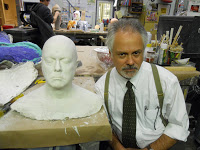
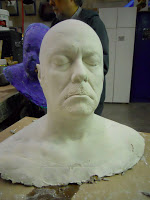
 RSS Feed
RSS Feed